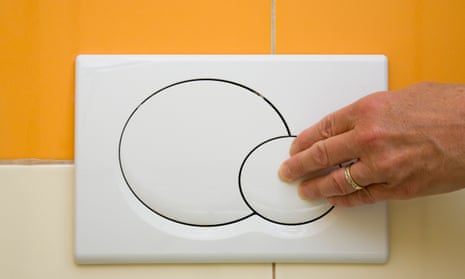Toilets specially designed to save water are wasting more than they conserve, the UK’s largest water firm has warned.
Campaigners have warned for years that dual-flush toilets, introduced as more efficient alternatives that were expected to use less than half the amount of water per flush, are more prone to leaks.
The problem is said to be so great that the costs are outweighing the benefits.
“Because there’s so many loos that continuously flow all through the day and night, collectively that water loss is now exceeding the amount of water the dual-flush design should be saving,” said Andrew Tucker, water efficiency manager at Thames Water.
“The volume of water loss is getting bigger every day as more people refurbish and retrofit older toilets and as more homes are built, so it’s a growing problem.”
The campaign group Waterwise has estimated that about 400m litres of water leak from UK toilets every day. It says that would be enough to supply 2.8 million people; equivalent to the combined populations of Edinburgh, Cardiff, Belfast, Manchester, Sheffield, Liverpool and Bristol.
The group has said that a single leaking toilet wastes an average of between between 215 and 400 litres of water per day and that between 5% and 8% of all toilets are leaky. And the majority of those use the newer dual-flush mechanism.
Thames Water said poor design and materials cause water to flow continuously into the bowl. And, according to the BBC, the Bathroom Manufacturers Association has acknowledged that the design of many dual-flush toilets is inherently more prone to leakage.
The majority of them use the drop valve system, which sits at the bottom of the cistern and opens to allow the water to flow out when the flush is pressed. Debris and other issues can cause the mechanism to fail to close, meaning water continually flows from the cistern and into the bowl.
Older cisterns tend to use a siphon system, which works by pushing water upwards until it reaches a point at which it can flow into the bowl. Because that point is above the waterline when the toilet is not being flushed, the system is less likely to develop the same sort of leak.
“A siphon will not leak whereas an outlet valve – if we look at the figures we’ve got – they could leak within a week of installation. It could be two years but they will leak,” said Jason Parker, the managing director of Thomas Dudley Ltd, one of the UK’s largest plumbing manufacturers.
He told the BBC: “If we’re serious about wasting water and we want to stop it, the only way to do that is put a siphon back in.”
Dual-flush toilets have two buttons that allow different quantities of water to flow. They typically put out four or six litres, with the smaller quantity meant for clearing urine.
Waterwise has said that fixing leaky toilets could “contribute around 10% of the additional water capacity needed to cope with an extreme drought in England by 2050”.









